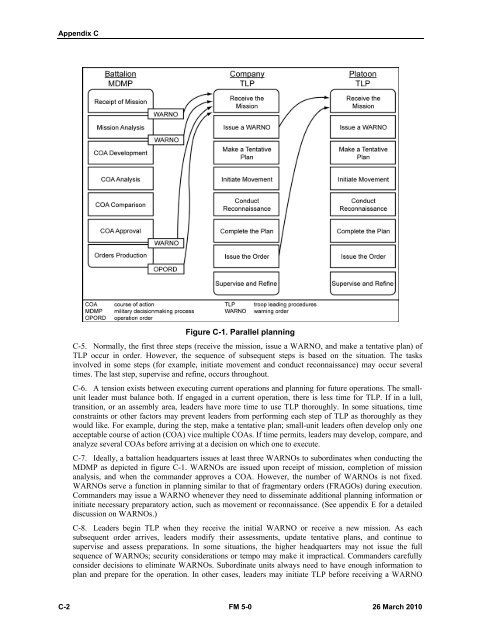FM 5-0, The Operations Process - Federation of American Scientists
FM 5-0, The Operations Process - Federation of American Scientists
FM 5-0, The Operations Process - Federation of American Scientists
Create successful ePaper yourself
Turn your PDF publications into a flip-book with our unique Google optimized e-Paper software.
Appendix C<br />
Figure C-1. Parallel planning<br />
C-5. Normally, the first three steps (receive the mission, issue a WARNO, and make a tentative plan) <strong>of</strong><br />
TLP occur in order. However, the sequence <strong>of</strong> subsequent steps is based on the situation. <strong>The</strong> tasks<br />
involved in some steps (for example, initiate movement and conduct reconnaissance) may occur several<br />
times. <strong>The</strong> last step, supervise and refine, occurs throughout.<br />
C-6. A tension exists between executing current operations and planning for future operations. <strong>The</strong> smallunit<br />
leader must balance both. If engaged in a current operation, there is less time for TLP. If in a lull,<br />
transition, or an assembly area, leaders have more time to use TLP thoroughly. In some situations, time<br />
constraints or other factors may prevent leaders from performing each step <strong>of</strong> TLP as thoroughly as they<br />
would like. For example, during the step, make a tentative plan; small-unit leaders <strong>of</strong>ten develop only one<br />
acceptable course <strong>of</strong> action (COA) vice multiple COAs. If time permits, leaders may develop, compare, and<br />
analyze several COAs before arriving at a decision on which one to execute.<br />
C-7. Ideally, a battalion headquarters issues at least three WARNOs to subordinates when conducting the<br />
MDMP as depicted in figure C-1. WARNOs are issued upon receipt <strong>of</strong> mission, completion <strong>of</strong> mission<br />
analysis, and when the commander approves a COA. However, the number <strong>of</strong> WARNOs is not fixed.<br />
WARNOs serve a function in planning similar to that <strong>of</strong> fragmentary orders (FRAGOs) during execution.<br />
Commanders may issue a WARNO whenever they need to disseminate additional planning information or<br />
initiate necessary preparatory action, such as movement or reconnaissance. (See appendix E for a detailed<br />
discussion on WARNOs.)<br />
C-8. Leaders begin TLP when they receive the initial WARNO or receive a new mission. As each<br />
subsequent order arrives, leaders modify their assessments, update tentative plans, and continue to<br />
supervise and assess preparations. In some situations, the higher headquarters may not issue the full<br />
sequence <strong>of</strong> WARNOs; security considerations or tempo may make it impractical. Commanders carefully<br />
consider decisions to eliminate WARNOs. Subordinate units always need to have enough information to<br />
plan and prepare for the operation. In other cases, leaders may initiate TLP before receiving a WARNO<br />
C-2 <strong>FM</strong> 5-0 26 March 2010















